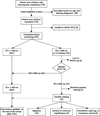Genetic variants for long QT syndrome among infants and children from a statewide newborn hearing screening program cohort
- PMID: 24388587
- PMCID: PMC3943925
- DOI: 10.1016/j.jpeds.2013.11.011
Genetic variants for long QT syndrome among infants and children from a statewide newborn hearing screening program cohort
Abstract
Objectives: Autosomal recessive long QT syndrome (LQTS), or Jervell and Lange-Nielsen syndrome (JLNS), can be associated with sensorineural hearing loss. We aimed to explore newborn hearing screening combined with electrocardiograms (ECGs) for early JLNS detection.
Study design: In California, we conducted statewide, prospective ECG screening of children ≤ 6 years of age with unilateral or bilateral, severe or profound, sensorineural or mixed hearing loss. Families were identified through newborn hearing screening and interviewed about medical and family histories. Twelve-lead ECGs were obtained. Those with positive histories or heart rate corrected QT (QTc) intervals ≥ 450 ms had repeat ECGs. DNA sequencing of 12 LQTS genes was performed for repeat QTc intervals ≥ 450 ms.
Results: We screened 707 subjects by ECGs (number screened/number of responses = 91%; number of responses/number of families who were mailed invitations = 54%). Of these, 73 had repeat ECGs, and 19 underwent gene testing. No subject had homozygous or compound heterozygous LQTS mutations, as in JLNS. However, 3 individuals (with QTc intervals of 472, 457, and 456 ms, respectively) were heterozygous for variants that cause truncation or missplicing: 2 in KCNQ1 (c.1343dupC or p.Glu449Argfs*14; c.1590+1G>A or p.Glu530sp) and 1 in SCN5A (c.5872C>T or p.Arg1958*).
Conclusions: In contrast to reports of JLNS in up to 4% of children with sensorineural hearing loss, we found no examples of JLNS. Because the 3 variants identified were unrelated to hearing, they likely represent the prevalence of potential LQTS mutations in the general population. Further studies are needed to define consequences of such mutations and assess the overall prevalence.
Published by Mosby, Inc.
Conflict of interest statement
The authors declare no conflicts of interest.
Figures



Similar articles
-
"Homozygous, and compound heterozygous mutation in 3 Turkish family with Jervell and Lange-Nielsen syndrome: case reports".BMC Med Genet. 2017 Oct 16;18(1):114. doi: 10.1186/s12881-017-0474-8. BMC Med Genet. 2017. PMID: 29037160 Free PMC article.
-
Novel combinations of variations in KCNQ1 were associated with patients with long QT syndrome or Jervell and Lange-Nielsen syndrome.BMC Cardiovasc Disord. 2023 Aug 12;23(1):399. doi: 10.1186/s12872-023-03417-2. BMC Cardiovasc Disord. 2023. PMID: 37568094 Free PMC article.
-
Prevalence of Jervell-Lange Nielsen syndrome in children with congenital bilateral sensorineural hearing loss.Turk Kardiyol Dern Ars. 2021 Jul;49(5):368-376. doi: 10.5543/tkda.2021.44890. Turk Kardiyol Dern Ars. 2021. PMID: 34308870
-
KCNQ1 mutations associated with Jervell and Lange-Nielsen syndrome and autosomal recessive Romano-Ward syndrome in India-expanding the spectrum of long QT syndrome type 1.Am J Med Genet A. 2016 Jun;170(6):1510-9. doi: 10.1002/ajmg.a.37636. Epub 2016 Apr 4. Am J Med Genet A. 2016. PMID: 27041150 Review.
-
[Jervell and Lange-Nielsen syndrome].Lin Chuang Er Bi Yan Hou Tou Jing Wai Ke Za Zhi. 2019 Sep;33(9):825-829. doi: 10.13201/j.issn.1001-1781.2019.09.007. Lin Chuang Er Bi Yan Hou Tou Jing Wai Ke Za Zhi. 2019. PMID: 31446697 Review. Chinese.
Cited by
-
Inherited arrhythmias: The cardiac channelopathies.Ann Pediatr Cardiol. 2015 Sep-Dec;8(3):210-20. doi: 10.4103/0974-2069.164695. Ann Pediatr Cardiol. 2015. PMID: 26556967 Free PMC article. Review.
-
Genomic and Non-Genomic Regulatory Mechanisms of the Cardiac Sodium Channel in Cardiac Arrhythmias.Int J Mol Sci. 2022 Jan 26;23(3):1381. doi: 10.3390/ijms23031381. Int J Mol Sci. 2022. PMID: 35163304 Free PMC article. Review.
-
Clinical and molecular findings in a Moroccan family with Jervell and Lange-Nielsen syndrome: a case report.J Med Case Rep. 2017 Apr 2;11(1):88. doi: 10.1186/s13256-017-1243-1. J Med Case Rep. 2017. PMID: 28364778 Free PMC article.
-
Comparison of formulas for calculation of the corrected QT interval in infants and young children.J Pediatr. 2015 Apr;166(4):960-4.e1-2. doi: 10.1016/j.jpeds.2014.12.037. Epub 2015 Jan 31. J Pediatr. 2015. PMID: 25648293 Free PMC article.
-
Mutational and phenotypic spectra of KCNE1 deficiency in Jervell and Lange-Nielsen Syndrome and Romano-Ward Syndrome.Hum Mutat. 2019 Feb;40(2):162-176. doi: 10.1002/humu.23689. Epub 2018 Dec 12. Hum Mutat. 2019. PMID: 30461122 Free PMC article.
References
-
- Jervell A, Lange-Nielsen F. Congenital deaf-mutism, functional heart disease with prolongation of the Q-T interval and sudden death. Am Heart J. 1957;54:59–68. - PubMed
-
- Schwartz PJ, Spazzolini C, Crotti L, Bathen J, Amlie JP, Timothy K, et al. The Jervell and Lange-Nielsen syndrome: natural history, molecular basis, and clinical outcome. Circulation. 2006;113:783–790. - PubMed
-
- Fraser GR, Froggatt P, James TN. Congenital Deafness Associated with Electrocardiographic Abnormalities, Fainting Attacks and Sudden Death. a Recessive Syndrome. Q J Med. 1964;33:361–385. - PubMed
Publication types
MeSH terms
Substances
Grants and funding
LinkOut - more resources
Full Text Sources
Other Literature Sources
Medical
Miscellaneous

